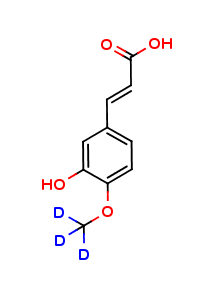Isoferulic Acid is an organic chemical with the molecular formula is C10H10O4. Isoferulic Acid is soluble in Chloroform, Dichloromethane, Ethyl Acetate, DMSO, Acetone, etc. Isoferulic Acid consists of trans-cinnamic acid bearing methoxy and hydroxy substituents at positions 4 and 3 respectively on the phenyl ring.

Scientists at Creative Proteomics utilize a highly quantitative method with high-performance liquid chromatography (HPLC) for the determination of Isoferulic Acid levels in various samples, including Plant, Blood and more. High-Performance Liquid Chromatography (HPLC) with UV detection is used for the determination of Isoferulic Acid (320 nm) levels in a lot of biological samples. This Methodology provides accurate, reliable, and reproducible results of Isoferulic Acid measurement, which enables us to analyze of Isoferulic Acid levels in vitro and in vivo.
There are some research paper have reported that Isoferulic Acid can inhibit the activity of the monophenolase and diphenolase to the mushroom tyrosinase under the experimental condition. Isoferulic Acid also can inhibit the activity of the fructose and glucose resulting in the regulation protein glycation and oxidation in the bovine serum albumin. Isoferulic Acid can inhibit the formation of AGEs and oxidation-dependent protein damage, so that Isoferulic Acid might be a new promising target for the prevention of diabetic complications. In both lipid and aqueous media, Isoferulic Acid is also an effective natural antioxidant. Isoferulic Acid is also can be act as a cosmetic additive because Isoferulic Acid can absorb UV and prevent oxidation. At the same time, Isoferulic Acid can inhibit the function of tyrosinase and has the function of depigmentation, which can prevent the generation of melanin. Isoferulic Acid can be extracted from the rice bran in a larger amount.
The Russian-Polish botanist M. Tswett is generally recognized as the first person to establish the principles of chromatography. In a paper he presented in 1906, Tswett described how he filled a glass tube with chalk powder (CaCO3) and, by allowing an ether solution of chlorophyll to flow through the chalk, separated the chlorophyll into layers of different colors. He called this technique “chromatography”. Fundamentally, chromatography is a technique used to separate the components contained in a sample. High Performance Liquid Chromatography (HPLC) is a method able to separate non-volatile, thermally unstable, and polar components separate or in a mixture. HPLC is a type of chromatography that, because of its wide application range and quantitative accuracy, is regarded as an indispensable analytical technique, particularly in the field of organic chemistry. It is also widely used as a preparation technique for the isolation and purification of target components contained in mixtures.
Isoferulic Acid Analysis Service at Creative Proteomics supports your research in Isoferulic Acid Analysis. HPLC Based Analysis Service Platform enable us at Creative Proteomics offers you a state-of-the-art Analysis Service.
Sample Type
Plant, Blood and more
Method
High-Performance Liquid Chromatography (HPLC) with UV detection is used for the determination of Isoferulic Acid (320 nm) levels in a lot of biological samples. This Methodology provides accurate, reliable, and reproducible results of Isoferulic Acid measurement, which enables us to analyze of Isoferulic Acid levels in vitro and in vivo.
Send us your samples, you will get all information that you need!







